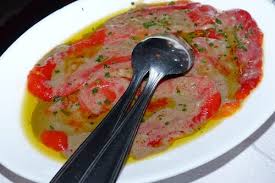I can think of no better way to begin this month's three-part segment on the French Riviera than with an overview of the tastes of this magical area. I’ll be flying to Nice soon and I’m already contemplating what I’ll order for my first night's dinner. Fifty years ago Julia Child wrote about the restaurant in which I’ll be dining. Julia lamented that Les Arcades in Biot was one of the last bastions of true Niçoise cooking on the French Riviera. Les Arcades is still owned by the same family as it was when Julia visited. Having dined at Les Arcades over twenty times, I couldn’t agree more that its menu today is even more of a rarity. This article will explain Niçoise cuisine and why it has become an endangered species.
Arcade's roasted red peppers with anchoiade sauce is going to be my starterNice’s culinary profile is a true fusion cuisine of its past conquerors. It begins with the Greeks who arrived on the Riviera by boat 600 B.C. They brought with them olives & olive oil, as well as a ubiquitous fish soup (now known as bouillabaisse). The Romans, who arrived 500 years later on foot with their own olives & olive oil, named this area “Provencia.” Not only did the name stick (Provence) but so did these Roman dishes:
~ Anchoiade: a thick anchovy paste made with olive oil, vinegar & garlic. It's used to flavor everything.
~ Fougasse: a baked flatbread very similar to ancient focaccia baked in outdoor community ovens.
~ Pissaladière: thin crusted bread topped with carmelized onions, olives, anchovies & olive oil.
But the Romans are not the only Italian influence on Nice’s gastronomic ways. The French Riviera was part of Italy’s House of Savoy from 1388 to 1860. During this nearly 500 year period, Italian foods became even more prominent in this French area. Here’s a sampling of Italy’s gifts to the French Riviera:
- Pesto became pistou
- Farinata (Italy’s chick pea pancake) became socca
- Tuna salad from the area of Genoa became Salade Niçoise
Niçoise olives are very tiny black bundles of super-charged flavor
So why is Niçoise cuisine a dying art-form? The French Riviera receives five million tourists annually and they come from every country in the world. Tastes are changing and restaurants reflect this globalization of food; for example there are > 200 Asian restaurants in Nice and > 400 Italian restaurants. Sushi and pizza have become more popular than bouillabaisse. Eating habits are changing, e.g. fast food is becoming more common. Many travelers also equate French food with complicated rich sauces, so super simple French dishes are often an oxymoron. Finally, while nearly every seaside restaurant on the French Riviera has a Salad Niçoise on its menu not even these salads are truly Niçoise---the authentic version does not include potatoes, green beans or lettuce!
Stay tuned for the following two articles in this Riviera trio: A Foodie’s Stroll Through Historic Nice, and Provence's don't miss outdoor markets.





No comments:
Post a Comment